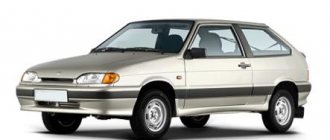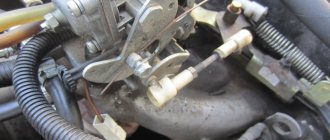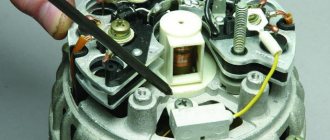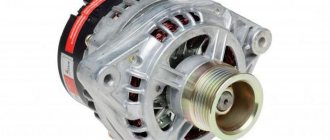Perhaps the most famous car from the USSR is the Zhiguli. So many of them were produced that even now they are often found in cities. One of the popular models of the “Classics” family is the VAZ-21053. The common people called the car “five” (by analogy with the “troika”, “four” and other VAZ cars). What is the VAZ-21053? Specifications, photos and reviews are further in our article.
Inexpensive AvtoVAZ model
In 2008-2009, the car was considered the cheapest on the Russian market. For reasons of market conditions, prices were steadily declining, since the demand for the car was insignificant. Its popularity was not helped by its ascetic equipment and lack of accessories that make the car a comfortable means of transportation. In addition, during that period the VAZ-2107 model appeared - a direct competitor to the “five”. Since the unification was almost one hundred percent, it was decided to produce only one of them - the VAZ-2107.
At a dead center
The VAZ-21053 model, just like its “sisters”, has not been modernized in any way during the entire production period. The exterior remained unchanged for years, and the driving characteristics also remained unnoticed by the AvtoVAZ engineering sector. Nobody thought about interior design improvements. The result of such inattention was a drop in demand, which resulted in discontinuation of production.
Brake system
The VAZ-21053 model was equipped with efficient dual-circuit hydraulics. From the central brake cylinder, pressure was supplied to the front and rear wheels according to a separate scheme. One pipeline connected the cylinder to the left front and right rear wheels, and the other connected the left rear wheel to the right front. This separation provided braking in case of failure of one of the circuits.
The front brakes, non-ventilated disc pads, were driven by a caliper covering the brake disc on both sides. The pistons were equipped with special rubber sealing rings that returned them to their original position after each press on the brake pedal.
The rear brakes, drum type, consisted of two self-adjusting shoes, driven by a hydraulic cylinder. The pads returned to their original position under the action of a spring. The design also included a handbrake mechanism controlled from the interior. The handbrake lever was located in the cabin, between the front seats.
Tuning
Recently, the “stens” movement has become increasingly popular. So, the owners tune the VAZ-21053 by installing:
- Classic alloy wheels with a wide shelf.
- Arch extensions.
- JDM style mirrors (placed on the hood).
- “Lips” in the front of the car.
- Spoiler in ducktail style.
The reader can see what the Soviet “five” looks like after this tuning in the photo below.
This car really attracts attention.
Subcompact car VAZ-21053, photo and description
Since 1999, a collapse in prices began on the Russian automobile market, caused by the 1998 default. The VAZ-21053 model, whose engine left much to be desired in terms of gas distribution parameters and some other characteristics, also suffered from unstable market conditions. Stores selling cars, one after another, refused deliveries. Demand for the VAZ-21053 car, the technical specifications of which have not been updated for years, was moderate, starting in 2000 until the closure of production in 2009. After the Oka minicar was discontinued in November 2008, the Lada-2105 and all its modifications became the cheapest cars on the Russian market.
Chassis of the “five”
It is almost similar to other classic VAZ models. Thus, an independent spring suspension with transverse swing arms was installed on the front of the car. There is also a stabilizer bar at the front. At the rear there is a spring dependent suspension with longitudinal and transverse bars. The brake system is hydraulic, dual-circuit, with a vacuum booster. Disc brakes are installed at the front, drum brakes at the rear. The handbrake is mechanical, with drive to the rear wheels.
As reviews note, the suspension on the “five” is very soft. It is able to dampen vibrations even at high speeds. But at the same time, the suspension did not tolerate sharp impacts. Due to breakdowns, owners were faced with deformation of the axles of the lower arms. Also, due to the excessively soft suspension, the car took turns poorly and was practically uncontrollable at high speeds. Reviews include all hinge joints as weak points in the chassis. These are steering rods and ball joints. The shock absorbers quickly became unusable due to the large suspension travel. Also, due to low-grade metal, wheel bearings have to be replaced frequently.
At the moment, the VAZ-21053 can be purchased at an average price of 15 to 60 thousand rubles. The condition of the cars will vary, as will the mileage. But the most expensive are the “fresh” copies released in 2010. The price can reach up to 120 thousand rubles.
Recycling program
The car was not in demand, and the manufacturer had already begun to suffer losses. The situation was smoothed out after the introduction of a recycling program, when the owner of an old car received 50,000 rubles from the state as compensation for melting it down. During this period, all AvtoVAZ models, including the VAZ-21053, again became in demand. Prices rose, and then a balancing act began between the cost of the scrappage certificate and the market value of the car. This continued until the model was removed from the assembly line (2009).
Why did the car attract buyers, albeit few? First of all, the availability of spare parts and components, which were relatively inexpensive. In addition, the attractiveness of the VAZ-21053 for Russians was the possibility of repairing and servicing it on their own (in the garage, on the site, or simply “in the field”). This circumstance somewhat leveled out the low demand for the car, but its prestige on the world market fell hopelessly. The car was no longer equipped with even the most necessary accessories; it got to the point that at the beginning of 2009, the daily mileage counter was removed from the dashboard.
Salon
Inside, the car looks the same as the “four” and “seven”. The driver has a four-spoke steering wheel without any adjustment and a flat fabric seat. The instrument panel on the VAZ-21053 is a pointer panel with modest backlighting. Nevertheless, everything necessary was located here: speedometer, tachometer, fuel level and antifreeze temperature sensor.
By the way, the “five” became the first car among the “Classics”, which was standardly equipped with a heated rear window. In addition, the front door windows have been ventilated in the cabin. However, in order to place deflectors in the panel, it was necessary to reduce the already small-sized glove compartment. The interior here is so simple that the only electronic items are interior lighting and rear window heating. All window regulators are mechanical. The seats are manually adjustable. Among the shortcomings in the interior, the owners note:
- Poor sound insulation. It is very noisy inside, especially at speed, when the roar of the engine can be heard from under the hood.
- Uncomfortable seats. Although they received height-adjustable headrests, they were extremely uncomfortable. There was no lumbar and lateral support. In addition, the seats quickly sank and rubbed. Because of this, you could often see covers on the seats of Zhiguli cars.
- Bad ergonomics. In particular, this concerned the steering wheel and inconvenient controls on the stove.
Reviews
Reviews of the VAZ-21053 model have never been enthusiastic. The owners noted shortcomings in the gas distribution system. The camshaft belt drive, which often failed, caused a lot of criticism. During the period when the VAZ-03 and VAZ-06 engine with a chain drive was installed on the car, there were no such complaints.
If there are any positive reviews from car owners, they relate to the area of car repair and maintenance: all consumers note the relatively low prices for spare parts and the possibility of repairs in their own garage.
We're sorry, but the requests coming from your IP address appear to be automated. For this reason, we are forced to temporarily block access to the site.
To continue, please enter the characters from the image in the input field and click "Submit".
Cookies are disabled in your browser
. We will not be able to remember you and correctly identify you in the future. To enable cookies, follow the tips on this page.
Specifications
| Manufacturer | Autoconcern "AvtoVAZ" |
| Start year of release | 1979 |
| Volume, cm³ | 1294 |
| Power, l. With | 64 |
| Torque, Nm | 94 |
| Compression ratio | 8.8 |
| Cylinder block | cast iron |
| Number of cylinders | 4 |
| cylinder head | aluminum |
| Fuel injection order | 1-3-4-2 |
| Cylinder diameter, mm | 79 |
| Piston stroke, mm | 66 |
| Timing drive | belt |
| Number of valves per cylinder | 2 |
| Turbocharging | No |
| Hydraulic compensators | No |
| Valve timing regulator | No |
| Lubrication system capacity, l | 3.75 |
| Oil used | 5W-30, 5W-40, 10W-40 |
| Oil consumption (calculated), l/1000 km | 0.7 |
| Fuel supply system | carburetor* |
| Fuel | gasoline AI-93 |
| Environmental standards | Euro 0 |
| Resource, thousand km | 125 |
| Location | longitudinal |
| Weight, kg | 104 |
| Tuning )potential), l. With | 200** |
*1.5 liter injection engines with a power of 140 hp. s, **without loss of resource 80 l. With
Why did it happen so?
Perhaps the automatic requests do not belong to you, but to another user accessing the network from the same IP address as you. You need to enter the characters into the form once, after which we will remember you and be able to distinguish you from other users exiting from this IP. In this case, the page with the captcha will not bother you for quite a long time.
You may have add-ons installed in your browser that can make automatic search requests. In this case, we recommend that you disable them.
It is also possible that your computer is infected with a virus program that is using it to collect information. Maybe you should check your system for viruses.
If you have any problems or would like our support team, please use the feedback form.
Main malfunctions of VAZ 2105 engines
If you do not take into account the power plants of the BTM 341 and VAZ 4132, the VAZ 2105 engines are not much different from each other. They have a similar design, and, therefore, they experience the same malfunctions. The main signs that the motor has failed are:
- impossibility of starting it;
- unstable operation at idle;
- violation of normal temperature conditions (overheating);
- power drop;
- change in exhaust color (white, gray);
- the occurrence of extraneous noise in the power unit.
Let's find out what the listed symptoms may indicate.
Inability to start the engine
The power unit will not start if:
- lack of voltage on the spark plugs;
- problems in the power system that prevent the fuel-air mixture from entering the cylinders.
The absence of a spark at the spark plug electrodes may be due to a malfunction:
- the candles themselves;
- high-voltage wires;
- ignition distributor;
- ignition coils;
- breaker (for cars with contact ignition);
- switch (for cars with contactless ignition)
- Hall sensor (for cars with a contactless ignition system);
- ignition switch.
Fuel may not flow into the carburetor and from there into the cylinders due to:
- clogged fuel filter or fuel line;
- fuel pump malfunction;
- obstruction of the carburetor inlet filter;
- malfunction or incorrect carburetor adjustment.
Unstable operation of the power unit at idle speed
Violation of the stability of the power unit at idle may indicate:
- malfunction of the carburetor solenoid valve;
- failure of one or more spark plugs, breakdown of insulation or violation of the integrity of the current-carrying conductor of a high-voltage wire;
- burning of breaker contacts;
- improper adjustment of the quantity and quality of fuel used to form the fuel-air mixture.
More about the VAZ 2105 ignition system: https://bumper.guru/klassicheskie-modeli-vaz/elektrooborudovanie/zazhiganie/kak-vystavit-zazhiganie-na-vaz-2105.html
Overheat
The normal temperature of a running VAZ 2105 engine is 87–950C. If its performance exceeds the limit of 950C, the engine overheats. This can lead not only to burnout of the cylinder block gasket, but also to jamming of moving parts inside the power unit. The causes of overheating may be:
- insufficient coolant level;
- low-quality antifreeze (antifreeze);
- faulty thermostat (cycling the system in a small circle);
- clogged (clogged) cooling radiator;
- air lock in the cooling system;
- Radiator cooling fan failure.
Reduced power characteristics
Engine power may decrease when:
- use of low-quality fuel;
- incorrectly set timing and ignition timing;
- burning of breaker contacts;
- violation of regulations on the quality and quantity of fuel used to form the fuel-air mixture;
- wear of piston group parts.
Exhaust color change
The exhaust gases of a working power unit look like steam and smell exclusively of burnt gasoline. If thick white (gray) gas comes from the exhaust pipe, this is a sure sign that oil or coolant is burning in the cylinders along with the fuel. Such a power unit will not “live” for a long time without major repairs.
The causes of thick white or bluish exhaust are:
- burnout (breakdown) of the cylinder head gasket;
- damage (crack, corrosion) to the cylinder head;
- wear or damage to piston group parts (cylinder walls, piston rings).
Knocks inside the engine
A working power unit produces many different sounds, which, merging, form a pleasant rumbling, indicating that all components and mechanisms are working harmoniously. But if you hear extraneous noises, in particular knocking, this should alert you. They are a sure sign of a serious malfunction. In an engine, similar sounds can be produced by:
- valves;
- piston pins;
- connecting rod bearings;
- main bearings;
- timing chain.
Valves knock due to:
- unregulated increase in thermal gap;
- wear (fatigue) of springs;
- wear of the camshaft cams.
The knocking of the piston pins usually occurs when the ignition timing is not adjusted. In this case, the fuel-air mixture ignites ahead of time, which provokes detonation.
Faulty connecting rod and main bearings of the crankshaft also cause extraneous noise in the engine. When they wear out, the gap between the moving elements of the crankshaft increases, which causes backlash, accompanied by a high-frequency knock.
As for the timing chain, it can create extraneous sounds if it is stretched and the damper is faulty.











